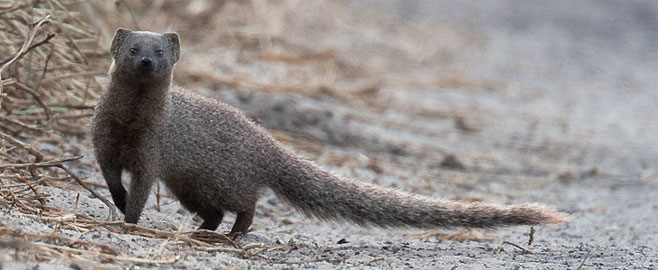Cape Grey Mongoose – Galerella Pulverulenta (Small Grey Mongoose, Kleingrysmuishond)



Pictures and more info:
http://www.biodiversityexplorer.org/mam ... ulenta.htm
Info: The Mammal Guide of Southern Africa, Burger Chillè, Briza publishers.
Description:
From a distance it looks grey, but from closer is actually black with white of yellowish speckles. Animals from the North-western region are more brown than the paler ones of the south. The hair on the head is short and lies flat, ears slightly covered. The hair at the base of the tail is long and becomes shorter towards the tip. The underparts are without the speckles and the legs are darker than the upper parts.
Sexual dimorphism:
Males are slightly larger than females.
Food:
Insects, mice, carrion, birds and small reptiles.
Habitat:
Utilizes a variety of habitats from fynbos to forests to very dry or mountainous areas, even parts of spares vegetation.
Distribution Africa:
 Habits:
Habits:
Diurnal with a decrease of activity during the warmer time of day. Usually solitary, sometimes in pairs. Young stay in breeding burrows till weaned, then start to moving around independently. They are mainly terrestrial, but can hunt in trees. Uses stacks of rocks, holes in termite heaps, as well as other holes for shelter, if sufficient vegetation is not available. Are not afraid of humans and prefer walking in footpaths. (They are commonly found in Cape Town gardens.)
Voice:
Unknown
Breeding:
Young are usually born from August to December.
Enemies:
Leopard, caracal, black-backed Jackal.
Info: The Mammal Guide of Southern Africa, Burger Chillè, Briza publishers.






